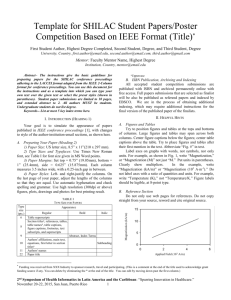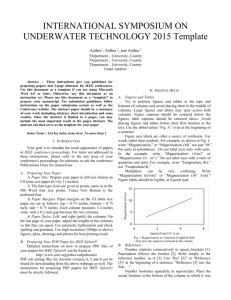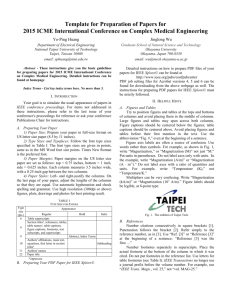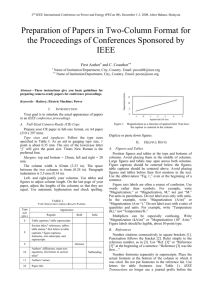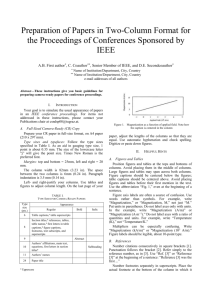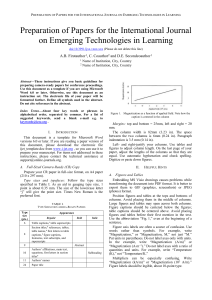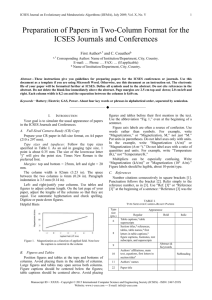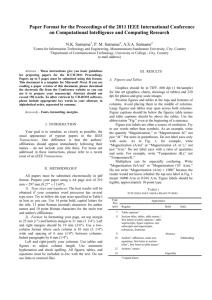Preparation of Papers in Two-Column Format for the Conference
advertisement
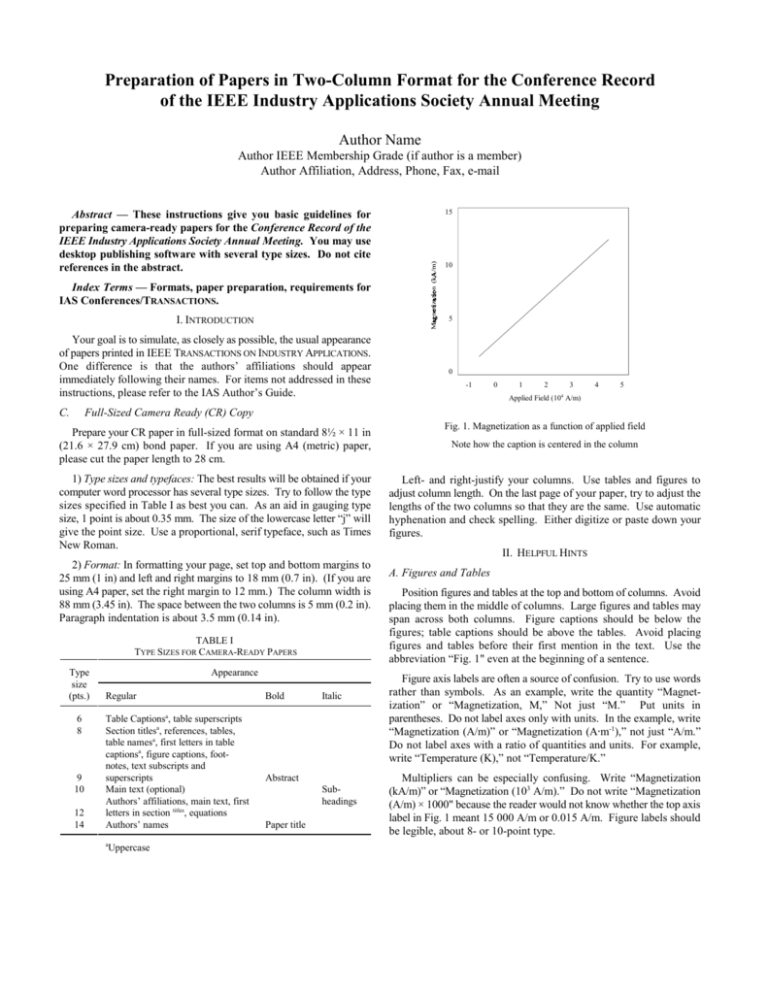
APPENDIX II Preparation of Papers in Two-Column Format for the Conference Record of the IEEE Industry Applications Society Annual Meeting Author Name Author IEEE Membership Grade (if author is a member) Author Affiliation, Address, Phone, Fax, e-mail 15 Abstract — These instructions give you basic guidelines for preparing camera-ready papers for the Conference Record of the IEEE Industry Applications Society Annual Meeting. You may use desktop publishing software with several type sizes. Do not cite references in the abstract. 10 Index Terms — Formats, paper preparation, requirements for IAS Conferences/TRANSACTIONS. 5 I. INTRODUCTION Your goal is to simulate, as closely as possible, the usual appearance of papers printed in IEEE TRANSACTIONS ON INDUSTRY APPLICATIONS. One difference is that the authors’ affiliations should appear immediately following their names. For items not addressed in these instructions, please refer to the IAS Author’s Guide. C. 0 -1 0 1 2 3 4 5 Applied Field (104 A/m) Full-Sized Camera Ready (CR) Copy Fig. 1. Magnetization as a function of applied field Prepare your CR paper in full-sized format on standard 8½ × 11 in (21.6 × 27.9 cm) bond paper. If you are using A4 (metric) paper, please cut the paper length to 28 cm. 1) Type sizes and typefaces: The best results will be obtained if your computer word processor has several type sizes. Try to follow the type sizes specified in Table I as best you can. As an aid in gauging type size, 1 point is about 0.35 mm. The size of the lowercase letter “j” will give the point size. Use a proportional, serif typeface, such as Times New Roman. 2) Format: In formatting your page, set top and bottom margins to 25 mm (1 in) and left and right margins to 18 mm (0.7 in). (If you are using A4 paper, set the right margin to 12 mm.) The column width is 88 mm (3.45 in). The space between the two columns is 5 mm (0.2 in). Paragraph indentation is about 3.5 mm (0.14 in). TABLE I TYPE SIZES FOR CAMERA-READY PAPERS Type size (pts.) 6 8 9 10 12 14 Appearance Regular Table Captionsa, table superscripts Section titlesa, references, tables, table namesa, first letters in table captionsa, figure captions, footnotes, text subscripts and superscripts Main text (optional) Authors’ affiliations, main text, first letters in section titles, equations Authors’ names Bold Italic Abstract Subheadings Paper title Note how the caption is centered in the column Left- and right-justify your columns. Use tables and figures to adjust column length. On the last page of your paper, try to adjust the lengths of the two columns so that they are the same. Use automatic hyphenation and check spelling. Either digitize or paste down your figures. II. HELPFUL HINTS A. Figures and Tables Position figures and tables at the top and bottom of columns. Avoid placing them in the middle of columns. Large figures and tables may span across both columns. Figure captions should be below the figures; table captions should be above the tables. Avoid placing figures and tables before their first mention in the text. Use the abbreviation “Fig. 1" even at the beginning of a sentence. Figure axis labels are often a source of confusion. Try to use words rather than symbols. As an example, write the quantity “Magnetization” or “Magnetization, M,” Not just “M.” Put units in parentheses. Do not label axes only with units. In the example, write “Magnetization (A/m)” or “Magnetization (A#m-1),” not just “A/m.” Do not label axes with a ratio of quantities and units. For example, write “Temperature (K),” not “Temperature/K.” Multipliers can be especially confusing. Write “Magnetization (kA/m)” or “Magnetization (103 A/m).” Do not write “Magnetization (A/m) × 1000" because the reader would not know whether the top axis label in Fig. 1 meant 15 000 A/m or 0.015 A/m. Figure labels should be legible, about 8- or 10-point type. a Uppercase -19- B. References III. UNITS Number citations consecutively in square brackets [1]. The sentence punctuation follows the bracket [2]. Refer simply to the reference number, as in [3]. Do not use “Ref. [3]” or “reference [3]” except at the beginning of a sentence: “Reference [3] was the first...” Number footnotes separately in superscripts. Place the actual footnote at the bottom of the column in which it was cited. Use letters for table footnotes (see Table I). IEEE Transactions no longer use a journal prefix before the volume number. For example, use “IEEE Trans. Magn., vol. 25,” not “vol. MAG-25.” Give all authors’ names; do not use “et al.” unless there are six or more authors. Papers that have not been published, even if they have been submitted for publication, should be cited as “unpublished” [4]. Papers that have been accepted for publication should be cited as “in press” [5]. Capitalize only the first word in a paper title, except for proper nouns and element symbols. For papers published in translation journals, please give the English citation first, followed by the original foreign-language citation [6]. C. Abbreviations and Acronyms Define abbreviations and acronyms the first time they are used in the text, even after they have been defined in the abstract. Abbreviations such as IEEE, SI, MKS, CGS, ac, dc, and rms do not have to be defined. Do not use abbreviations in the title unless they are unavoidable (for example, the title of this article). D. The International System of Units (SI units) is advocated for use in IEEE publications. An exception would be the use of English units as identifiers in trade, such as “3.5-inch disk drive” or “1-inch conduit.” If other quantities must be expressed in English units, the SI equivalent must also be given in parentheses: “... a distance of 4.7 in (12 cm).” IV. SOME COMMON MISTAKES The word “data” is plural, not singular. The subscript for the permeability of vacuum 0 is zero, not a lower case letter “o.” In American English, periods and commas are within quotation marks, like “this period.” A parenthetical statement at the end of a sentence is punctuated outside the closing parenthesis (like this). (A parenthetical sentence is punctuated within the parentheses.) A graph within a graph is an “inset,” not an “insert.” The word “alternatively” is preferred to the word “alternately” (unless you really mean something that alternates). Do not use the word “essentially” to mean “approximately” or “effectively.” Be aware of the different meanings of the homophones “affect” and “effect,” “complement” and “compliment,” “discreet” and “discrete,” “principal” and “principle.” Do not confuse “imply” and “infer.” The prefix “non” is not a word; it should be joined to the word it modifies, usually without a hyphen. There is no period after the “et” in the Latin abbreviation “et al.” The abbreviation “i.e.” means “that is” and the abbreviation “e.g.” means “for example.” An excellent style manual and source of information for science writers is [7]. ACKNOWLEDGMENT Equations Number equations consecutively with equation numbers in parentheses flush with the right margin, as in (1). To make your equations more compact, you may use the solidus(/), the exp function, or appropriate exponents. Italicize roman symbols for quantities and variables, but not Greek symbols. Use a long dash rather than a hyphen for a minus sign. Punctuate equations with commas or periods when they are part of a sentence, as in a+b=c. The preferred spelling of the word “acknowledgment” in America is without an “e” after the “g.” Try to avoid the stilted expression , “One of us (R. B. G.) thanks ...” Instead, try “R. B. G. thanks...” Put sponsor acknowledgments in an unnumbered footnote on the first page. REFERENCES [1] (1) Be sure that the symbols in your equations have been defined before the equation appears or immediately following. Use “(1),” not “Eq. (1)” or “equation (1),” except at the beginning of a sentence: “Equation (1) is...” [2] [3] E. Other Recommendations The Roman numerals used to number the section headings are optional. If you do use them, number INTRODUCTION, but not ACKNOWLEDGMENT or REFERENCES, and begin Subheadings with letters. Use two spaces after periods (full stops). Hyphenate complex modifiers: “zero-field-cooled magnetization.” Avoid dangling participles, such as, “Using (1), the potential was calculated.” Write instead, “The potential was calculated using (1),” or “Using (1), we calculated the potential.” Use a zero before decimal points: “0.25,” not “.25.” Use “cm3,” not “cc.” Do not mix complete spellings and abbreviations of units: “Wb/m2" or “webers per square meter,” not “webers/m2.” Spell units when they appear in text: “...a few henrys,” not “...a few H.” (Note that the correct plural of the unit “henry” is “henrys,” not “henries.”) If your native language is not English, try to get a native English speaking colleague to proofread your paper. Number each page at the top, right corner: “1 of 5,” “2 of 5," etc. [4] [5] [6] [7] -20- G. Eason, B. Noble, and I.N. Sneddon, “On certain integrals of Lipschitz-Hankel type involving products of Bessel functions,” Phil. Trans. Roy. Soc. London, vol. A247, pp. 529-551, April 1955. J. Clerk Maxwell, A Treatise on Electricity and Magnetism, 3rd ed., vol. 2. Oxford: Clarendon, 1892, pp. 68-73. I.S. Jacobs and C.P. Bean, “Fine particles, thin films and exchange anisotropy,” in Magnetism, vol. III, G.T. Rado and H. Suhl, Eds. New York: Academic, 1963, pp. 271-350. K. Elissa, “Title of paper if known,” unpublished. R. Nicole, “Title of paper with only first word capitalized,” J. Name Stan. Abbrev., in press. Y. Yorozu, M. Hirano, K. Oka, and Y. Tagawa, “Electron spectroscopy studies on magneto-optical media and plastic substrate interface,” IEEE Transl. J. Magn. Japan, vol. 2, pp. 740-741, August 1987 [Digests 9th Annual Conf. Magnetics Japan, p. 301, 1982]. M. Young, The Technical Writer’s Handbook. Mill Valley, CA: University Science, 1989.
